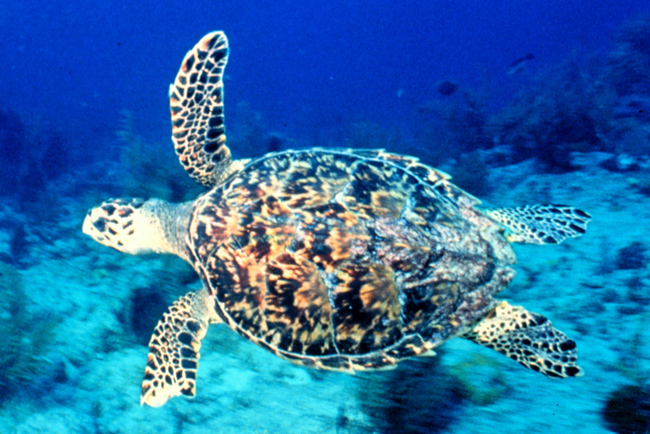
The hawksbill turtle (E. imbricata) is one of the many marine turtles which are being threatened
today. During the 20th century, the
species nesting population has dramatically been reduced (84%- 87% decline)
over the last ten years due to various threats imposing on the
species, therefore being listed as critically endangered throughout its range.
Some threats include:
Trade and direct take of products
This is one of the most severe
threats affecting E. imbricata. Capture
of this species is done intentionally for the consumption of its meat or
selling of its shell. It is renowned that several fishermen strategically catch
hawksbills with nets and harpoons. An additional commercial good extracted from
the hawksbill is the utilization of its egg which has become an extreme
commercial item that is used in trade for funds or other commodities.
Incidental catch
Some hawksbills are caught in
longlines which can have a major negative impact on some populations of the hawksbill
with very few members such as causing an entire population to diminish and this
in turn can affect the marine food web. Fishermen capture hawksbills
incidentally by the use of traps, gillnets and trawls and specimens between
3-20 kg are accidentally caught in fishing traps whereas larger species members
are more frequently trapped in gillnets.
Debris and logs are transported
and deposited on the shorelines of beaches which cause large barriers to
nesting. Debris can cause ingestion risk and entanglement to hawksbills and
also reduce their ability to grow, feed and survive. Also, chemicals such as
copper and mercury from homes, cruise lines, factories, vehicles and farms are
discarded in various water paths and end up in the oceans. These excess
nutrients can cause harmful algal blooms and can damage their health by causing
hormonal imbalances.
Coastal development
Construction of structures (hotel
sites or houses) alter the morphology of the coastal zone which encourages
increase of human presence, noise level, sand mining, erosion and lighting. Hatchling
survival is reduced, deterrence of nesting occurs and even eggs shed at sea
when the quality of nesting beaches are compromised. Artificial lighting
interferes with the nesting behaviours of adult female hawksbills. The
artificial lighting confuses the hatchlings by moving in the direction of the
brightest area as they find their way from nest to sea.
While individual populations worldwide
prolong to disappear because of the present establishment of exploitation,
degradation of habitat and additional threats towards hawksbills can cause the species to go extinct in
the foreseeable future. Relevant activities such as enforcement of law and
proper management need to be universally initiated if populations of E. imbricata.
References:
IAC Secretariat. 2010. Report of
the “Regional Workshop on the Hawksbill turtle in the Wider Caribbean and Western Atlantic.” Puerto Morelos, Quintana Roo, México.
23-25 September 2009. IAC, CITES, SPAW,
CONANP, SEMARNAT, WWF. 56 pp. Accessed
March 15 2015. http://www.iacseaturtle.org/engdocs/publicaciones/Hawksbill_Report_Final_ENG.pdf
IUCN. 2014. The IUCN Red List of Threatened Species. Accessed March 17 2015. http://www.iucnredlist.org/static/categories_criteria_3_1
National Marine Fisheries Service
and U.S. Fish and Wildlife Service. 1993. "Recovery Plan for Hawksbill Turtles
in the U.S. Caribbean Sea, Atlantic Ocean, and Gulf of Mexico." National Marine Fisheries Service, St. Petersburg, Florida.
Accessed March 18 2015. http://www.nmfs.noaa.gov/pr/pdfs/recovery/turtle_hawksbill_atlantic.pdf
Salafsky, Nick, Daniel Salzer,
Alison J. Stattersfield, Craig Hilton-Taylor, Rachel Neugarten, Stuart H. M. Butchart,
Ben Collen, Neil Cox, Lawrence L. Master, Sheila O’connor, and David Wilkie. 2008. " A Standard Lexicon for Biodiversity
Conservation: Unified Classifications
of Threats and Actions." Conservation Biology DOI:
10.1111/j.1523- 1739.2008.00937.x